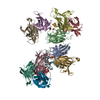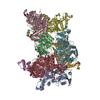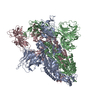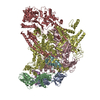[English] 日本語
 Yorodumi
Yorodumi- PDB-6r5k: Cryo-EM structure of a poly(A) RNP bound to the Pan2-Pan3 deadenylase -
+ Open data
Open data
- Basic information
Basic information
| Entry | Database: PDB / ID: 6r5k | ||||||
|---|---|---|---|---|---|---|---|
| Title | Cryo-EM structure of a poly(A) RNP bound to the Pan2-Pan3 deadenylase | ||||||
 Components Components |
| ||||||
 Keywords Keywords | RNA BINDING PROTEIN / poly(A)-tail / mRNA / RNP / PABP / Pab1 / Pan2-Pan3 / Ccr4-Not / deadenylase / RRM / cryoEM | ||||||
| Function / homology |  Function and homology information Function and homology informationregulation of nuclear-transcribed mRNA poly(A) tail shortening / PAN complex / Deadenylation of mRNA / ribonuclease inhibitor activity / poly(A)-specific ribonuclease / poly(A)-specific ribonuclease activity / nuclear-transcribed mRNA poly(A) tail shortening / poly(A) binding / mRNA 3'-end processing / DNA damage tolerance ...regulation of nuclear-transcribed mRNA poly(A) tail shortening / PAN complex / Deadenylation of mRNA / ribonuclease inhibitor activity / poly(A)-specific ribonuclease / poly(A)-specific ribonuclease activity / nuclear-transcribed mRNA poly(A) tail shortening / poly(A) binding / mRNA 3'-end processing / DNA damage tolerance / regulation of translational initiation / poly(U) RNA binding / intracellular membraneless organelle / mRNA transport / mRNA 3'-UTR binding / promoter-specific chromatin binding / P-body / molecular condensate scaffold activity / mRNA processing / cytoplasmic stress granule / nucleic acid binding / protein kinase activity / ribosome / ribonucleoprotein complex / DNA repair / mRNA binding / RNA binding / zinc ion binding / ATP binding / metal ion binding / nucleus / cytoplasm / cytosol Similarity search - Function | ||||||
| Biological species |   | ||||||
| Method | ELECTRON MICROSCOPY / single particle reconstruction / cryo EM / Resolution: 4.8 Å | ||||||
 Authors Authors | Schaefer, I.B. / Conti, E. | ||||||
 Citation Citation |  Journal: Cell / Year: 2019 Journal: Cell / Year: 2019Title: Molecular Basis for poly(A) RNP Architecture and Recognition by the Pan2-Pan3 Deadenylase. Authors: Ingmar B Schäfer / Masami Yamashita / Jan Michael Schuller / Steffen Schüssler / Peter Reichelt / Mike Strauss / Elena Conti /  Abstract: The stability of eukaryotic mRNAs is dependent on a ribonucleoprotein (RNP) complex of poly(A)-binding proteins (PABPC1/Pab1) organized on the poly(A) tail. This poly(A) RNP not only protects mRNAs ...The stability of eukaryotic mRNAs is dependent on a ribonucleoprotein (RNP) complex of poly(A)-binding proteins (PABPC1/Pab1) organized on the poly(A) tail. This poly(A) RNP not only protects mRNAs from premature degradation but also stimulates the Pan2-Pan3 deadenylase complex to catalyze the first step of poly(A) tail shortening. We reconstituted this process in vitro using recombinant proteins and show that Pan2-Pan3 associates with and degrades poly(A) RNPs containing two or more Pab1 molecules. The cryo-EM structure of Pan2-Pan3 in complex with a poly(A) RNP composed of 90 adenosines and three Pab1 protomers shows how the oligomerization interfaces of Pab1 are recognized by conserved features of the deadenylase and thread the poly(A) RNA substrate into the nuclease active site. The structure reveals the basis for the periodic repeating architecture at the 3' end of cytoplasmic mRNAs. This illustrates mechanistically how RNA-bound Pab1 oligomers act as rulers for poly(A) tail length over the mRNAs' lifetime. | ||||||
| History |
|
- Structure visualization
Structure visualization
| Movie |
 Movie viewer Movie viewer |
|---|---|
| Structure viewer | Molecule:  Molmil Molmil Jmol/JSmol Jmol/JSmol |
- Downloads & links
Downloads & links
- Download
Download
| PDBx/mmCIF format |  6r5k.cif.gz 6r5k.cif.gz | 607.1 KB | Display |  PDBx/mmCIF format PDBx/mmCIF format |
|---|---|---|---|---|
| PDB format |  pdb6r5k.ent.gz pdb6r5k.ent.gz | 456.6 KB | Display |  PDB format PDB format |
| PDBx/mmJSON format |  6r5k.json.gz 6r5k.json.gz | Tree view |  PDBx/mmJSON format PDBx/mmJSON format | |
| Others |  Other downloads Other downloads |
-Validation report
| Summary document |  6r5k_validation.pdf.gz 6r5k_validation.pdf.gz | 1.2 MB | Display |  wwPDB validaton report wwPDB validaton report |
|---|---|---|---|---|
| Full document |  6r5k_full_validation.pdf.gz 6r5k_full_validation.pdf.gz | 1.2 MB | Display | |
| Data in XML |  6r5k_validation.xml.gz 6r5k_validation.xml.gz | 87.7 KB | Display | |
| Data in CIF |  6r5k_validation.cif.gz 6r5k_validation.cif.gz | 133.7 KB | Display | |
| Arichive directory |  https://data.pdbj.org/pub/pdb/validation_reports/r5/6r5k https://data.pdbj.org/pub/pdb/validation_reports/r5/6r5k ftp://data.pdbj.org/pub/pdb/validation_reports/r5/6r5k ftp://data.pdbj.org/pub/pdb/validation_reports/r5/6r5k | HTTPS FTP |
-Related structure data
| Related structure data |  4728MC M: map data used to model this data C: citing same article ( |
|---|---|
| Similar structure data |
- Links
Links
- Assembly
Assembly
| Deposited unit | 
|
|---|---|
| 1 |
|
- Components
Components
-Protein , 2 types, 4 molecules ADFH
| #1: Protein | Mass: 127186.602 Da / Num. of mol.: 1 Source method: isolated from a genetically manipulated source Source: (gene. exp.)  Gene: PAN2, YGL094C / Cell line (production host): Hi5 / Production host:  Trichoplusia ni (cabbage looper) / References: UniProt: P53010, poly(A)-specific ribonuclease Trichoplusia ni (cabbage looper) / References: UniProt: P53010, poly(A)-specific ribonuclease |
|---|---|
| #2: Protein | Mass: 64778.363 Da / Num. of mol.: 3 Source method: isolated from a genetically manipulated source Source: (gene. exp.)  Gene: PAB1, YER165W / Production host:  |
-PAN2-PAN3 deadenylation complex subunit ... , 2 types, 2 molecules NO
| #4: Protein | Mass: 53218.609 Da / Num. of mol.: 1 Source method: isolated from a genetically manipulated source Source: (gene. exp.)  Gene: PAN3, ECM35, YKL025C / Cell line (production host): Hi5 / Production host:  Trichoplusia ni (cabbage looper) / References: UniProt: P36102 Trichoplusia ni (cabbage looper) / References: UniProt: P36102 |
|---|---|
| #5: Protein | Mass: 77906.688 Da / Num. of mol.: 1 Source method: isolated from a genetically manipulated source Source: (gene. exp.)  Gene: PAN3, ECM35, YKL025C / Cell line (production host): Hi5 / Production host:  Trichoplusia ni (cabbage looper) / References: UniProt: P36102 Trichoplusia ni (cabbage looper) / References: UniProt: P36102 |
-RNA chain / Non-polymers , 2 types, 3 molecules E

| #3: RNA chain | Mass: 29583.547 Da / Num. of mol.: 1 / Source method: obtained synthetically / Source: (synth.)  |
|---|---|
| #6: Chemical |
-Experimental details
-Experiment
| Experiment | Method: ELECTRON MICROSCOPY |
|---|---|
| EM experiment | Aggregation state: PARTICLE / 3D reconstruction method: single particle reconstruction |
- Sample preparation
Sample preparation
| Component |
| ||||||||||||||||||||||||||||||
|---|---|---|---|---|---|---|---|---|---|---|---|---|---|---|---|---|---|---|---|---|---|---|---|---|---|---|---|---|---|---|---|
| Molecular weight | Value: 0.498 MDa / Experimental value: NO | ||||||||||||||||||||||||||||||
| Source (natural) |
| ||||||||||||||||||||||||||||||
| Source (recombinant) |
| ||||||||||||||||||||||||||||||
| Buffer solution | pH: 7.5 | ||||||||||||||||||||||||||||||
| Specimen | Embedding applied: NO / Shadowing applied: NO / Staining applied: NO / Vitrification applied: YES | ||||||||||||||||||||||||||||||
| Specimen support | Grid material: COPPER / Grid mesh size: 300 divisions/in. / Grid type: Quantifoil R2/1 | ||||||||||||||||||||||||||||||
| Vitrification | Cryogen name: ETHANE-PROPANE |
- Electron microscopy imaging
Electron microscopy imaging
| Experimental equipment |  Model: Titan Krios / Image courtesy: FEI Company |
|---|---|
| Microscopy | Model: FEI TITAN KRIOS |
| Electron gun | Electron source:  FIELD EMISSION GUN / Accelerating voltage: 300 kV / Illumination mode: FLOOD BEAM FIELD EMISSION GUN / Accelerating voltage: 300 kV / Illumination mode: FLOOD BEAM |
| Electron lens | Mode: BRIGHT FIELD |
| Image recording | Average exposure time: 8 sec. / Electron dose: 51 e/Å2 / Detector mode: COUNTING / Film or detector model: GATAN K2 SUMMIT (4k x 4k) / Num. of grids imaged: 1 / Num. of real images: 6463 |
| Image scans | Sampling size: 5 µm / Movie frames/image: 40 / Used frames/image: 2-40 |
- Processing
Processing
| Software |
| ||||||||||||||||||||||||||||||||||||
|---|---|---|---|---|---|---|---|---|---|---|---|---|---|---|---|---|---|---|---|---|---|---|---|---|---|---|---|---|---|---|---|---|---|---|---|---|---|
| EM software |
| ||||||||||||||||||||||||||||||||||||
| CTF correction | Type: NONE | ||||||||||||||||||||||||||||||||||||
| Particle selection | Num. of particles selected: 2141230 | ||||||||||||||||||||||||||||||||||||
| Symmetry | Point symmetry: C1 (asymmetric) | ||||||||||||||||||||||||||||||||||||
| 3D reconstruction | Resolution: 4.8 Å / Resolution method: FSC 0.143 CUT-OFF / Num. of particles: 29165 / Num. of class averages: 1 / Symmetry type: POINT | ||||||||||||||||||||||||||||||||||||
| Atomic model building | B value: 45.7 / Protocol: RIGID BODY FIT / Space: REAL / Target criteria: Cross-correlation coefficient | ||||||||||||||||||||||||||||||||||||
| Refinement | Highest resolution: 4.8 Å / Stereochemistry target values: GeoStd + Monomer Library | ||||||||||||||||||||||||||||||||||||
| Refine LS restraints |
|
 Movie
Movie Controller
Controller









 PDBj
PDBj































